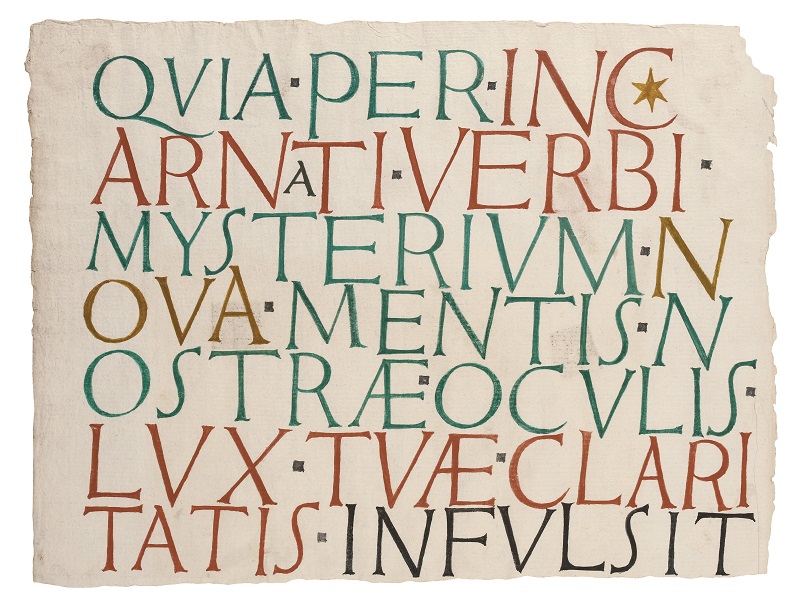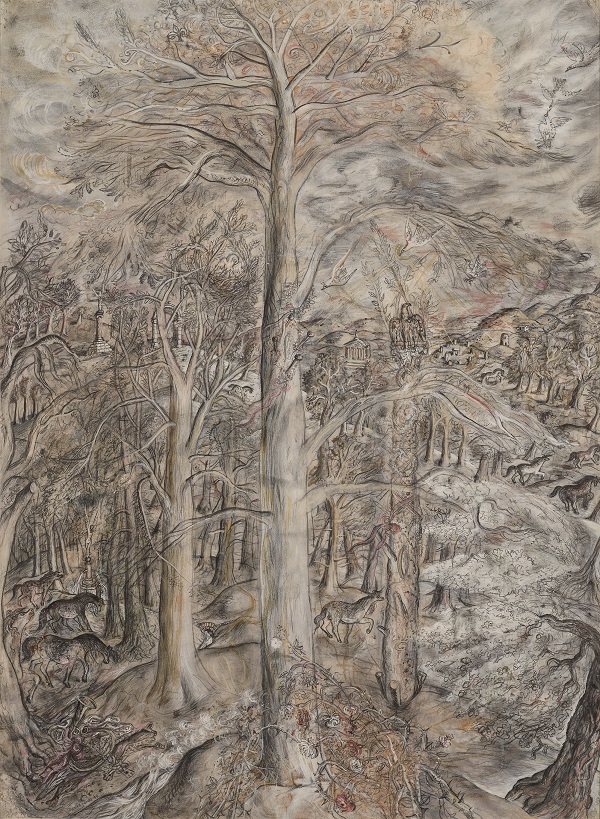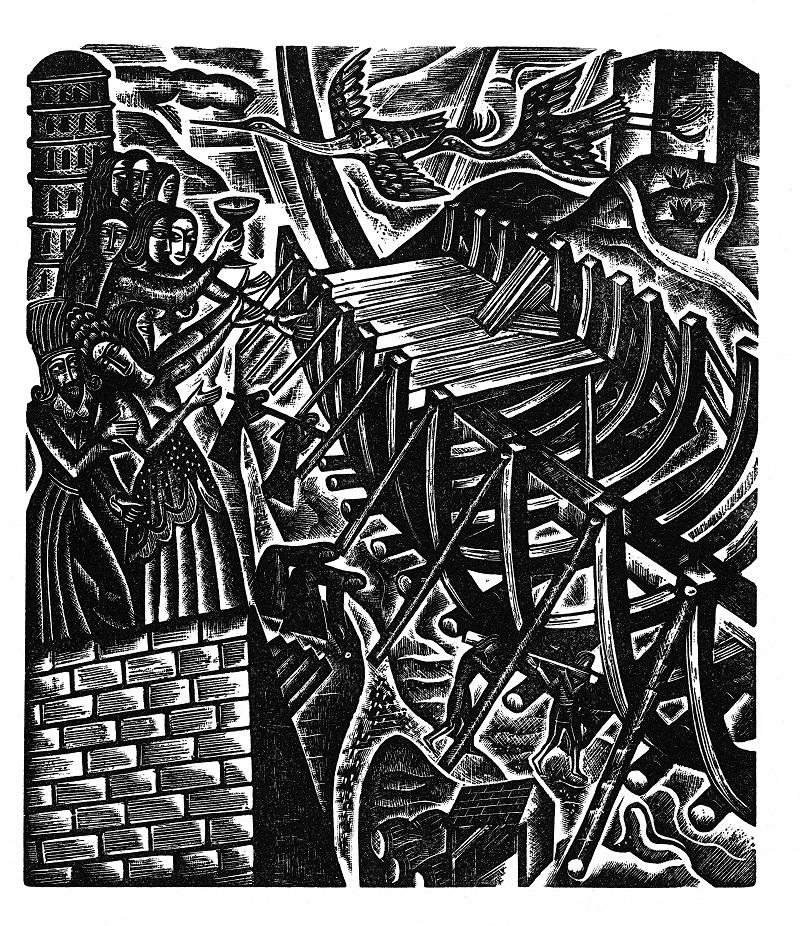Switching between the orderly and the chaotic, David Jones’ depiction of Noah’s family building the ark immerses us in the drama of the moment while simultaneously holding us at some point out of time, to emphasise the story’s ancient roots. Viewpoint and scale shift unnervingly to evoke the watery unsteadiness of the scene, building an intense psychological charge that balances the disorienting, claustrophobic treatment of space with patterns and reiterations that provide respite for the eye; pieces of timber, bricks in a wall, and pairs of figures and birds serve as punctuation to control and modulate pace. (Main picture: The Building of the Ark, from The Chester Play of the Deluge, 1927).
 Generating movement and tension through frequent tempo changes is a technique that recurs throughout David Jones’ work, and can be seen to riveting effect in the expressive brushstrokes of his Portrait of a Maker (Harman Grisewood), 1932, in which the image of his friend seems to shimmer in and out of focus, the smoothly painted sweep of the nose and brow echoing the curve of the hands, the lines of his lapels dissolving into the scumbled background. And in the preface to his poem In Parenthesis, 1937, his celebrated account of life in the trenches of World War I, Jones discusses his use of typographic idiosyncrasies to “indicate some change, inflexion, or emphasis”, explaining how the positioning of words and the insertion of space serves to “aid the sense and form”.
Generating movement and tension through frequent tempo changes is a technique that recurs throughout David Jones’ work, and can be seen to riveting effect in the expressive brushstrokes of his Portrait of a Maker (Harman Grisewood), 1932, in which the image of his friend seems to shimmer in and out of focus, the smoothly painted sweep of the nose and brow echoing the curve of the hands, the lines of his lapels dissolving into the scumbled background. And in the preface to his poem In Parenthesis, 1937, his celebrated account of life in the trenches of World War I, Jones discusses his use of typographic idiosyncrasies to “indicate some change, inflexion, or emphasis”, explaining how the positioning of words and the insertion of space serves to “aid the sense and form”.
Jones' appreciation of the effects achieved by the considered positioning of words on a page, and his sensitivity to the relationship between words and image must have been stimulated through observation of his father’s work as a printer, and it certainly culminated in the painted inscriptions that he made from the 1940s onwards (pictured above right: Quia Per Incarnati, 1945). During the 1920s, Jones served what amounted to an apprenticeship with the sculptor and typeface designer Eric Gill, joining his Guild of St Joseph and St Dominic at Ditchling, East Sussex, where as part of a renewed interest in craft practice inspired by the Arts and Crafts Movement, a revival of letterpress printing was in full swing. It was under Gill’s instruction that Jones learned wood-engraving, a technique favoured for book-illustration because it could be printed in combination with text.
The dense, dark wood engravings that Jones made to illustrate a series of three celebrated publications by the Golden Cockerel Press, including Gulliver’s Travels and The Book of Jonah, make a striking contrast to his illustrations for Coleridge’s The Rime of the Ancient Mariner, 1928, for which he used the intaglio technique of copper-engraving to achieve a more fluid, open effect that permits considerably more white space than the relief method of wood-engraving can allow. In The Albatross, from The Rime of the Ancient Mariner, Jones’ customary use of an unusual viewpoint suggests the rolling waves, our encounter with the stricken albatross placing us at the very heart of the action. And far below, those strange ethereal figures reaching up towards us surely owe something to Matisse, or even Picasso.
The sea is a recurring theme in Jones’ work, not least because it spoke to his sense of his own family’s maritime past. His maternal grandfather had been a mast-maker at Rotherhithe, and his father’s Welsh ancestry fuelled his sense of a romantic Celtic past which mingled with his experiences in the trenches to shape a poetic vision of shared history and experience. For Jones, the soldiers of his own generation were the direct descendants of the medieval knights, the animals on the hills, like the Roman horses running wild in Vexilla Regis, 1947-8, history’s constant, silent witnesses (pictured below).
In the later drawings and paintings, Jones’ deeply held Catholic faith combines with this sense of a collective history, with folk memory, biblical stories, myth and imagination vividly interwined. In Vexilla Regis, Calvary is set in the wilds of the Welsh countryside, a great tree pierced with nails to represent the crucifixion, a tangle of briars at its foot alluding to the crown of thorns. In the distance, classical ruins stand alongside a circle of standing stones; time here is indeterminate, beyond measure.
 The heavy and exhausting symbolism of this piece is characteristic of Jones’ later work, and it is easy to see why his art has been all but forgotten since his death in 1974, its biblical, literary and cultural allusions running counter to the prevailing currents of the past 40-odd years. Even so, it is perfectly possible to read a painting like Flora in Calix-Light, 1950, laden as it is with religious symbolism, as a simple still-life. A central vessel, like a chalice on an altar, overflows with flowers, but any symbolism is chased away by the beautiful, yet profane detail of the window latch, which curls around like a stem, and becomes one with the tangle of flowers that surround it.
The heavy and exhausting symbolism of this piece is characteristic of Jones’ later work, and it is easy to see why his art has been all but forgotten since his death in 1974, its biblical, literary and cultural allusions running counter to the prevailing currents of the past 40-odd years. Even so, it is perfectly possible to read a painting like Flora in Calix-Light, 1950, laden as it is with religious symbolism, as a simple still-life. A central vessel, like a chalice on an altar, overflows with flowers, but any symbolism is chased away by the beautiful, yet profane detail of the window latch, which curls around like a stem, and becomes one with the tangle of flowers that surround it.
In fact, this exhibition suggests that Jones started painting still-lifes like this one under the influence of Ben and Winifred Nicholson, who he met in 1927 before being invited to join the Seven and Five Society, of which Ben was the chairman, a year later. Certainly the vibrant colour combinations that began to feature in Jones’ paintings, a vase of flowers before an open window a favourite theme, owe much to Winifred, while his energetic marine paintings, with their expressive use of paint, are also suggestive of her influence.
Neither a painter who writes poetry nor a poet who paints, David Jones is revealed here as a truly all-round artist of remarkable reach. And yet however accomplished his paintings, it is without doubt his prints that really fascinate, and are worth going back to time and time again.









![SEX MONEY RACE RELIGION [2016] by Gilbert and George. Installation shot of Gilbert & George 21ST CENTURY PICTURES Hayward Gallery](/sites/default/files/styles/thumbnail_125_x_125_/public/mastimages/Gilbert%20%26%20George_%2021ST%20CENTURY%20PICTURES.%20SEX%20MONEY%20RACE%20RELIGION%20%5B2016%5D.%20Photo_%20Mark%20Blower.%20Courtesy%20of%20the%20Gilbert%20%26%20George%20and%20the%20Hayward%20Gallery._0.jpg?itok=3oW-Y84i)





Add comment